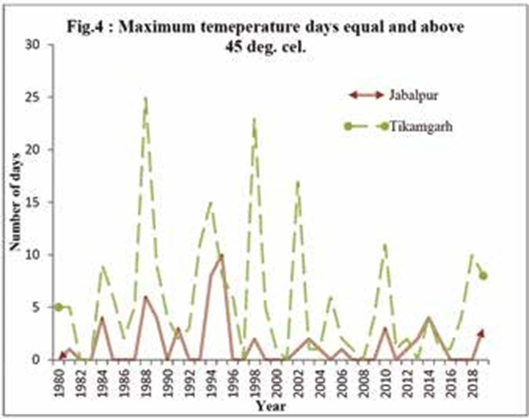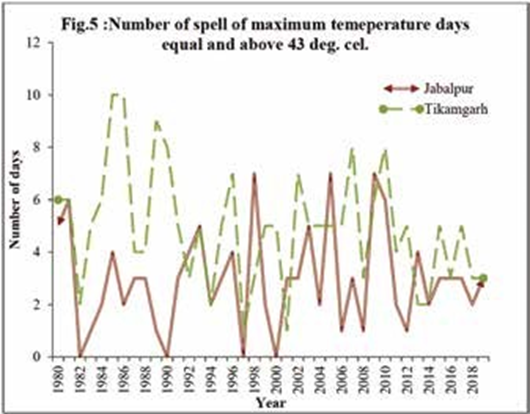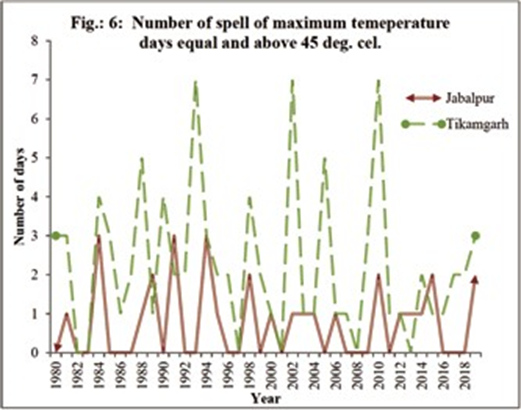Heatwaves events, magnitude
and its timing are changing with every passing year in India. In recent past
the month of March is reported as warmest year during past 121 years in India. It is projected that the central
parts of the country would be experienced more heat waves events up to mid of this century.
A number of publications have been reported
that during past two
decades heat waves events increased over central parts of India and many deaths had been observed.
The present analysis was carried out in eastern part of Madhya Pradesh and
observed that the heat wave during the past two decades irrespective of the
climatic conditions of a place has lowered.
Heat wave is a period
of abnormally high
(maximum) temperatures, which occurs during the summer season (March to June) in parts of India. It is reported that
climate changes leads to changes in the frequency, intensity, spatial extent,
duration, and timing of heat waves at global scale (Vimal et
al.,2020). India is also witness the impact of climate change and due to which
heat waves events, its duration and intensity with time have increased and witness distressing impact on human health (Ray et al., 2021).
It is reported
that central parts of India
in general and eastern
Madhya Pradesh in particular is more vulnerable to climate change and thus due
to heat waves (Vimal et al.,2020). In view of these, the present study is focused
over the eastern part of Madhya Pradesh. The two districts of eastern Madhya
Pradesh in which one is sub- humid climate (Jabalpur), other has semi-arid climate (Tikamgarh) were
selected. The Madhya Pradesh state comprises with hills, valley, plateau and
plain regions. The whole state is divided into 11 agroclimatic zone namely: Chhattisgarh plains,
Northern Hill Region,
Kymore Plateau & Satpura
Hills of Chhattisgarh, Central Narmada Valley, Vindhya Plateau,
Gird Region, Bundelkhand, Satpura Plateau, Malwa
Plateau, Nimar Plains and Jhabua Hills (Fig.2).
Among the 11 agroclimatic zones, two districts
representing the 2 agro
climatic zone were selected and their latitude and normal rainfall and temperatures are given in table

Table 1 : Climate
of the two selected districts
|
Name of the districts
|
Latitude
|
Longitude
|
Normal rainfall (m.m.)
|
Temperature (0C)
|
Relative humidity (%)
|
|
Maximum
|
Minimum
|
Morning
|
Evening
|
|
Tikamgarh
|
24°43’N
|
78°49’E
|
963.5
|
32.8
|
17.9
|
68
|
56
|
|
Jabalpur
|
23°16’N
|
79°58’E
|
1377.0
|
31.6
|
18.4
|
76
|
43
|
Extreme weather events and heat waves were observed
in these two districts in past
(Srivastava et al., 2020). The highest maximum temperature values were recorded 48.8°C
on 27 May 1998 at Tikamgarh,
48.6°C on 11 May 1984 at Jabalpur during past 40 years. As per India Meteorological
Department, March is observed the second warmest month during
past 121 years over central India.
This year(2022) heat waves over Tikamgarh district of Madhya Pradesh was observed
during first fortnight of the April month (Fig.2). The maximum
temperature was observed above 43°C from past
few days.
Heat waves
Extreme weather
events in general and heat wave in particular; are determining factor for
human, animal health as well as the agricultural production. To have an idea about heat waves events, its
extent in the two districts of eastern Madhya Pradesh long term observed
temperature data (1980- 2020) was analyzed and presented below:
Daily maximum temperature
data during the period 1980 - 2020 of the two districts were collected and
screened for heat waves and the following two criteria were adopted:
|
Decade
|
Number of
heat waves days at
Tikamgarh
|
Number of
heat waves days at
Jabalpur
|
|
1980-1989
|
348
|
158
|
|
1990-1999
|
337
|
150
|
|
2000-2009
|
226
|
110
|
|
2010-2019
|
208
|
124
|
|
|
Table 2 : Decadal variability heat waves
Heatwave is
considered, when observed maximum temperature of a station ≥ 43°C
Heatwave is
consider, when observed maximum temperature of a station ≥ 45°C
The number of
days equal to or above 43°C was screened out for both the districts and their
decadal number is presented
in table 2. It was noticed
that the number of heat waves day’s values were decreased over the decades at
both the districts. For further details; the annual analysis of the number of
days and spells of heat waves were also carried
out.
 Fig.2 : Heat wave condition over Tikamgarh during April 2022.
Fig.2 : Heat wave condition over Tikamgarh during April 2022.
Analysis of observed number of
maximum temperature days as well as
the spells of heat waves over
the eastern Madhya Pradesh on annual scales from 1980 to 2020 was carried out and presented
in figures 3 to 6. From the
figures 3 and 4 it was observed that the
number of days equal to and above 43 and 45°C were decreased both at
Tikamgarh and Jabalpur districts of Madhya Pradesh.
The decreasing trend of number of days equal to or above
43°C at Tikamgarh was found significant. Similarly the heat waves spells were also showed a decreasing trend at Tikamgarh and
Jabalpur, though the trends were found to be non-significant. The above
results suggest that though the central India’s climate is warming
up but eastern Madhya Pradesh
has not showed such trend. An analysis
reported by India Meteorological
Department on heat wave data (2017-2021) showed that 8-12 day-long heat wave spells were observed over Rajasthan, Madhya Pradesh, Haryana,
Chandigarh and Delhi, Punjab
and parts of Gujarat from April 2017 to 2019. Das et al., (2020) reported from 39 years of weather data analysis; that
the increasing trends of heat waves were found over Rajasthan, Haryana, Punjab,
East Madhya Pradesh, and Orissa. Nandi and Pillai (2022) reported that India
recorded its warmest March during past 121 years with maximum temperature
across the country was 1.9°C above its normal value. They further reported that March
2022 was the second warmest
in
121 years in
terms of maximum temperature over central India. Rajasthan, Madhya Pradesh, and
Maharashtra were among some of the worst-affected states
from the
extreme heat,
having experienced the longest spells of dry weather and extreme heat
conditions.In West Rajasthan, Churu experienced
50.8°C and Sri Ganganagar recorded 49.6°C
on 2nd June, 2019.
Adverse Impact of Heat
Waves
The heat wave
is natural disaster and spreading over time and affects the human, animal and
plant life. Heat waves occur more slowly and over a wider area than
typhoons, heavy rain, heavy snow, and
strong winds (Kim et al., 2020).
It was found that 3014 men died from heat-related causes during 2001–05, which increased to 5157
in the period
2011–15. Deaths caused by heatwaves were found
to be higher than those resulting from avalanches, exposure to cold,
cyclone, tornado, earthquake, epidemic, flood, landslide, torrential
rain and forest fire. The
impact of rising temperatures, its increasing frequency, duration and intensity
of hot spells in India poses a challenge to human safety and
sustainability for its 1.3 billion populations. The damage caused by other
natural disasters mostly results from external
physical forces such as
flooding and collapse, but in heat
waves, health problems occur mainly due to bodily exposure to high
temperatures. Therefore, the damage caused by heat waves is strongly
affected

not
only by heat waves themselves but also by the state of individuals’ health, their
residences, and working
conditions.
For the last
few years, heat waves during the summer season in India are increasingly affecting morbidity
and mortality in the country
(Figure 7).
The numbers
of deaths varies with region and are influenced by the demographics and socioeconomic
characteristics of the region(Kumar
and Singh,2021). Therefore, there is a need for targeted region-specific
interventions for reducing the number of deaths due to heat waves. Heat wave killed
thousands of people and has also caused death of cattle and wildlife
besides affecting animal’s health in India. The increased occurrences and
severity of heat - wave is a wake - up call for all the agencies to take
necessary action for prevention, preparedness and community
outreach to save the lives of the general public,
livestock and wild life.
Heat waves projections
Heat waves are
projected to be more intense, have longer durations
and occur at a higher frequency and earlier in the coming
years in future. In
India too, more frequent and intense heat waves are projected, which would negatively
impact vulnerable communities and thereby increase mortality. Severe heat waves is projected
over India by Mishra et al.(2017) and reported
that it would increase by about 15 and 92 times from the current level by the mid and end-21st century
respectively.
Way Forward
 Extreme heat can lead to serious health
consequences, including heat stress
and heat stroke. Heat related health impacts are found to be more severe in
urban areas, where residents are exposed
to higher and nocturnally sustained temperatures
compared to surrounding areas due to
a phenomenon called the Urban Heat Island (UHI) effect. Thus the heat waves significantly differ from other natural
disasters. Therefore, the strategy of
establishing countermeasures against heat waves by emulating policies for other
natural disasters has limitations. In order to devise appropriate
countermeasures against heat wave disasters, scientific research to support the
implementation of these counter measures should be carried out at micro level.
Extreme heat can lead to serious health
consequences, including heat stress
and heat stroke. Heat related health impacts are found to be more severe in
urban areas, where residents are exposed
to higher and nocturnally sustained temperatures
compared to surrounding areas due to
a phenomenon called the Urban Heat Island (UHI) effect. Thus the heat waves significantly differ from other natural
disasters. Therefore, the strategy of
establishing countermeasures against heat waves by emulating policies for other
natural disasters has limitations. In order to devise appropriate
countermeasures against heat wave disasters, scientific research to support the
implementation of these counter measures should be carried out at micro level.
References
Srivastava,
A. K., Yogranjan and Bal, Lalit M.,(2020), “Variability of extreme weather events
and its impact on crop yield in Bundelkhand Agroclimatic
zone of Madhya Pradesh” Mausam 71(2):551-560.
Ray, K., Giri, R.K., Ray, S.S., Dimri, A.P.,
Rajeevan,
M.,(2021). An Assessment of Long-term Changes in Mortalities due to Extreme
Weather Events in India: A Study of 50 Years’ Data, 1970-2019, Weather and
Climate Extremes, https://doi.org/10.1016/j.
wace.2021.100315.
Kumar Arvind
and Singh ,D.P.(2021). Heat stroke-related
deaths in India: An analysis
of natural causes of deaths, associated with the regional heat wave. Journal of
Thermal Biology, 95: https://doi.org/10.1016/j. jtherbio.2020.102792.
Das, Prabir Kumar, Podder, Ushashi, Das,
Rituparna, Kamalakannan, Chandrasekar,Goru, Srinivasa Rao
,Soumya,
Bandyopadhyay and Raj, Uday. (2020).Quantification of heat wave occurrences over the Indian region usinglong-term (1979–
2017)
daily gridded (0.5° × 0.5°)
temperaturedata—a combined heat wave index approach,
Theoretical and Applied
Climatology 142:497–511. Nandi Jayashree and Pillai Soumya (2022). Northwest
and central India heatwaves during the second half of the March. Hindustan Times 02
April,2022 .
Mishra
Vimal, Mukherjee Sourav, Kumar Rohini and Stone Dáithí A (2017).Heat wave
exposure in India in current,
1.5 °C, and 2.0 °C worlds.
Environmental Research Letters, 12(12) 124012.
Kim, Do-Woo, Kwon, Chaeyoung , Kim, Jineun, and Lee, Jong-Seol (2020). Characteristics of Heat Waves From a Disaster Perspective. J Prev Med Public
Health. Jan; 53(1): 26–28.
Vimal
Mishra, Udit Bhatia and Amar Deep Tiwari(2020). Bias-correlated climate
projections for south Asia from coupled model inter comparison project
6.Scientific data 7:338(1-13).







